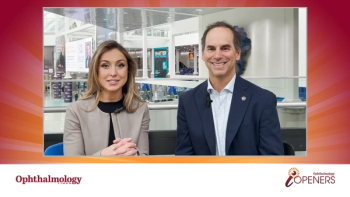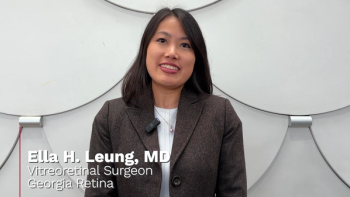
Productivity may be key factor for a successful practice
The margin between top-tier practices and smaller counterparts can vary
Ophthalmologists must be proactive to achieve success, and demographics play a key role in that planning. With an aging patient population, demand for quality eye care will continue to grow.
Reviewed by Derek A. Preece, MBA
Every physician who sets up his or her own office dreams of one day having a premier practice that is the envy of colleagues. Dreaming big may be the first step, but achieving the goal is another thing altogether.
There is a road map for success and its path can be found in the annual Academetrics benchmarking survey by the
During a presentation at the 2018 meeting of the American Academy of Ophthalmic Executives titled “Benchmarking: How Do TopTier Practices Differ From Average Practices?”
Preece is partner and executive consultant with
“The new doctors just are not coming into the field in higher numbers,” he said. “It is just flat.” A key factor in the numbers of ophthalmologists also is retirements, meaning that the numbers are shrinking slowly through attrition.
RELATED:
The AAO/AAOE benchmarking survey also provides information that is important for ophthalmologists to know, including how many patients their peers are seeing each day. For more than a decade, Preece has poured over the data to ensure it is accurate.
For his presentation, he looked at the top 10% of practices to see how their benchmarks are different from other practices. He ranked 88 cataract/anterior segment/comprehensive ophthalmology practices by income per
“I wanted to look at the anterior segment practices make the data as comparable as possible,” he said.
According to Preece, this ensured a level playing field, because a specialized practice could have more retina, but very little general or clinical and those differences would skew the results. The presentation is based on data for 2017, the most recent year that data was available.
Preece identified the top 10% and calculated the median results for that tier of the leading ophthalmic practices. He identified the practices from a second tier, which included practices between the 25th to 75th percentiles and their median results. He also identified the bottom 25th percentile of practices and median results from that third tier.
Preece then compared each of the three groups to determine the differences. They were ranked on the average income per physician, meaning available income before taxes. The average income for physicians in the top tier is $1,296,991, was nearly three times the $458,653 earned by doctors in the middle tier. The lower tier stands at about $213,658.
“This income includes salary and bonus as well as retirement income, and includes a mixture of owners and employed physicians,” Preece explained. “We don’t distinguish between the two for the AAO/ AAOE benchmarks.”
The benchmark survey also includes all of the money they get as dividends or profit distributions, if they are an owner. While he expected the top tier to be higher, Preece said he did not expect it to be triple the second tier of practices. He was curious to find out why.
“I thought that perhaps the larger practices just had a lower overhead ratio,” he said.
For the survey, overhead is considered all of the expenses of the practice but not including provider income and retirement contributions. Indeed, the data showed this to be true, with the top tier at a median overhead ratio of 52%. For the 25th-75th tier, the overhead ratio stood at 58% and for the bottom tier, it was 67%.
“That bottom category has high overhead,” Preece said. “Only about 33% of the money they generate is going toward provider income.”
That also would indicate that staff payroll ratios would differ across the three categories. Preece noted that
RELATED:
Preece then theorized that the top-tier practices must be getting by with fewer employees per physician and that’s why their payroll ratio is lower. The top practices have more full-time equivalent (FTE) employees per FTE physician than the lower two tiers, at 5.67. It is 5.33 for the middle group and 4.44 for the lower tier, according to the survey.
“This ratio includes all support employees and does not include providers,” he said. “The difference is not huge between the three groups, but clearly the
Staff at the top-tier companies also make more money on average than the other two groups-an average of just over $49,000.
“The key difference is that the ophthalmologists at top-tier companies produce just over $1.6 million per year on average in professional collections. This does not include ASC facility fees nor optical sales, just the clinic,” Preece explained.
For the second tier, that level is $950,512 and $484,933 for the lower tier. The figures are for the overall benchmark database, and do not reflect specific practices.
“It comes down to the doctors being more productive,” Preece said. “These figures are not charges, but collections coming in to the practice.”
RELATED:
Some of the difference in productivity between the physicians in the three tiers of the study lies in the number of surgeries top-tier ophthalmologists perform. These include more elective procedures, including
Patient volume is another factor, with top-tier physicians seeing an average of 5,264 patients per year, while middle-tier saw 5,023 and third-tiers saw an average of 3,607. The data also indicates that top-tier physicians, on average, produce more per patient seen.
Dividing all of the professional revenue they produce, including surgical revenues, tests and exams by the number of encounters (i.e. exams performed) yields a “revenue per encounter” benchmark. The top-tier physicians average $301 per encounter, while the middle group generates $200 and the lower group $174.
More patients, and a higher revenue generated per patient help explain the difference between the three tiers. In addition to higher productivity among top-tier ophthalmologists, they make efficient use of their staff. Total collections divided by total FTE support staff comes out to $171,101 for the top-tier practices, with $158,470 in the middle tier and $119,591 for the lower tier practices.
Preece noted that it may be expected that the toptier practices would generate more revenue per staff member, how the staff costs are divided can vary from practice to practice.
There are several factors that typically must align to fuel the performance of a top-tier practice. These factors include high demand for services, highly productive physicians, patient flow spread over fewer physicians and the right number of quality staff members to allow the physicians to be productive.
“Top-tier practices have high demand for a reason and that often comes down to customer service,” he said. “It depends on how the patient is treated.” The highly productive physicians typically are not working on tasks throughout the day that are not related to patient care.
“Very productive doctors spend their work time seeing patients or doing surgery and they are very productive and efficient,” Preece pointed out.
And regardless of how productive ophthalmologists might be, most of the time they want to be more productive. In part, this explains why patient flow often is spread between fewer doctors at top-tier practices.
RELATED:
“They do not generally want to spread it amongst more doctors,” he said. “They also are careful when adding new doctors and typically wait until demand requires it, and do not hire before they really need additional physicians.”
However, this can prove to be hard in some markets, when recruiting a talented ophthalmologist can be a challenge. Throughout the industry, there are more openings than there are qualified physicians to fill them. When a good candidate comes along, it may be wise to bring them aboard when the opportunity presents itself.
“If you are in a difficult market for recruiting, you may have to commit before you would like to because it could be a long time before another qualified candidate comes along,” Preece noted.
With a sufficient quality and quantity of staff,
Observation can determine whether staff is needed and if the staff you have is productive. That generally is a task performed by practice management. Training also is important to ensure that new and existing employees are efficient and know what they are doing.
RELATED:
There are also are several
Physicians can also review new patient ratio, expenses per encounter, collections per encounter, encounters per FTE provider, net collection ratio and revenues per FTE optician in the AAO/AAOE Academetrics benchmarking survey, which is free to those practices that participate by adding their data to the survey.
Ultimately, while there is no cookie cutter to create a successful practice, there are key factors that are common among the leading ophthalmologists. By following the path set by those physicians, you can increase your chances for success.
RELATED:
Disclosures:
Derek A. Preece, MBA
E: [email protected]
This article was adapted from Preece’s presentation at the 2018 meeting of the American Academy of Ophthalmic Executives. He has no financial interests or relationships to disclose. Allergan is a client of BSM Consulting.
Newsletter
Don’t miss out—get Ophthalmology Times updates on the latest clinical advancements and expert interviews, straight to your inbox.













































.png)


